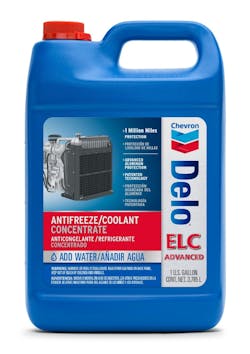Chevron’s New Coolant Chemistry Balances Nitrite’s Pros/Cons
Patented chemistry in Chevron’s new Delo ELC Advanced Antifreeze/Coolant is designed for double duty. The new coolant formulation, says Chevron, is based on organic-acid technology (OAT), but capitalizes on an inorganic additive, nitrite, for positive wet-cylinder-liner (wet-sleeve) protection. But the new chemistry also protects aluminum heat exchangers—manufactured via the controlled-atmosphere-brazing (CAB) process—from nitrite’s potentially harmful effects, while also inhibiting the formation of precipitates that can result from reactions between a residue of the CAB process and certain components in the OAT additive package.
Nitrite-containing OAT formulations, or NOATs, are commonly available and in some instances are preferred by heavy-duty-diesel manufacturers for nitrite’s proven ability to protect wet cylinder liners from the ravages of the cavitation/erosion/corrosion process. This process can occur when air bubbles created in the coolant by the vibrating liners implode with great force and pit the liner surface, eventually breaching the liner if the process goes unchecked. Nitrite does its job by creating a protective patina on the liner surface.
Other engine manufacturers, however, are of the opinion that coolant based on pure OAT chemistry (without nitrite) affords adequate liner protection via an electro-chemical process that does not use up the coolant’s additives. (Nitrite is used up as it does its job and, in some coolants, might need to be periodically replenished.)
A disadvantage of using nitrite in a NOAT formulation, says Dan Holdmeyer, Chevron’s Industrial and Coolants Manager, is nitrite’s reactivity with an engine’s aluminum components that are exposed to coolant, heat exchangers in particular. The CAB process, says Holdmeyer, uses flux that removes aluminum’s natural protective patina, allowing nitrite to react with the aluminum to form ammonia, which raises the coolant’s pH and causes it to become more alkaline (base). If the coolant’s pH level reaches 11 or higher (14 is the top of the base scale), the coolant can corrode aluminum.
To avoid this potential problem, the additive chemistry in Chevron’s Delo ELC (extended life coolant) Advanced Antifreeze/Coolant, says Holdmeyer, can “passivate” the aluminum, making it unreactive by altering the surface layer or coating the surface with a thin inert layer. In addition, says Holdmeyer, the new Delo antifreeze/coolant also prevents flux remaining on aluminum components from reacting with nitrite and other organic components in the OAT’s additive package, thus avoiding the potential problem of forming precipitates that could plug coolers and deplete the coolant’s additives.
“Chevron refers to the new antifreeze/coolant as a ‘stable pH product,’” says Holdmeyer, “and also refers to it as a ‘lowbrid’ product. NOAT formulations often are called ‘hybrids,’ because they’re using both organic and inorganic chemistry. But the ‘lowbrid’ term means that the Chevron chemistry uses only low (but effective) concentrations of nitrite, along with low concentrations of molybdenum—which further lowers the needed concentration of nitrite.”
According to Holdmeyer, the new antifreeze/coolant has an expected life of 1,000,000 miles or 20,000 hours and requires no extender additives, unless diluted with water or with a nitrite-free product. The company has a coolant-maintenance kit that allows testing for freeze point (concentration), nitrite level, pH, and the carboxylate (additive) level of the basic OAT formulation.
Among industry specifications the new product meets, says Holdmeyer, are ASTM D6210; ASTM D3306; Caterpillar EC-1; Deutz DQC CB-14; TCM RP 329, 302A, and 351; and the phosphate-free requirement of European engine manufacturers
Early next year, Chevron will introduce a reformulated nitrite-free antifreeze/coolant, Delo XLC Advanced, which will incorporate the company’s new chemistry. In this instance, says Holdmeyer, the new chemistry will stabilize the coolant’s pH from becoming too acidic, the potential result of residue from the CAB process reacting with components in the basic OAT formulation.





